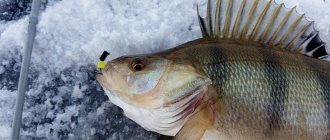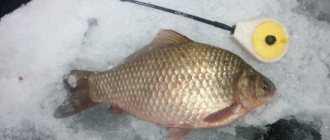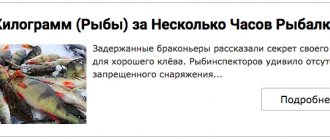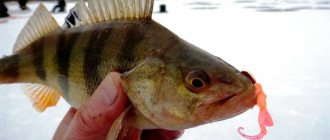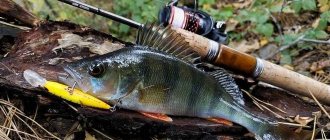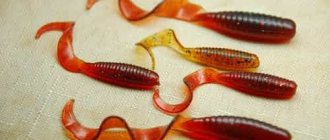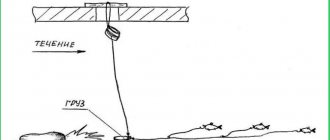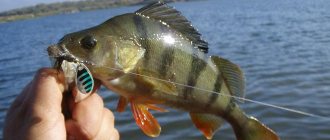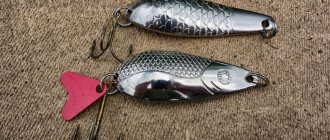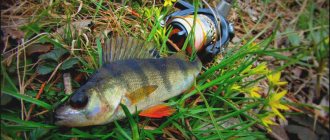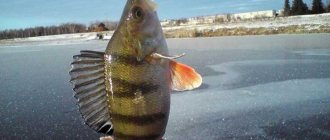Predator behavior in the first ice
For perch fishing on the first ice to be successful, you need to know the behavioral characteristics of this fish.
Perch is the most common fish in our country, reaching a weight of 2 kg. The usual size of the fish does not exceed 500 grams; larger specimens are rarely found and are called “humpbacks” in the fishing community. The predator inhabits both shallow ponds and large lakes, rivers and reservoirs. Ponds, small lakes and river bays are the first to be covered with ice, where schools of small fish, the main food of perch, immediately rush to in search of silence and protection. In addition to fish, perch readily feeds on small crustaceans, worms and larvae of aquatic insects and bloodworms.
Perch activity during this period
On the first ice, perch behaves very actively and can be perfectly caught throughout the daylight hours. Naturally, if the weather is favorable for this. As a rule, perch is caught well in clear, frosty weather, with even, preferably slightly increased, atmospheric pressure. The first bites begin at dawn. Unlike white fish, good lighting is important for perch.
Despite the fact that the first ice, as a rule, is characterized by a good perch bite, during the day it is caught in outings of varying duration. In November-December, the best bite lasts from morning until lunch. Then follows some break, and after lunch the bites continue.
As dusk approaches, the activity of the perch subsides. A good perch bite begins from the moment ice cover is established and, depending on the course of the winter and the region, lasts from two weeks to a month, or even a month and a half. Further, activity peaks coincide mainly with favorable weather conditions.
Up
Where to look for perch on the first ice
Perch, like other predatory fish, needs shelter to hunt successfully. It is very good if there is a snag or a flooded tree nearby. Perches make good use of changes in the bottom topography for hunting - the so-called edges, along which they begin to actively hunt. You should search for perch in the first ice from coastal areas with the strongest ice, making a series of holes towards the depth. The predator does not like silted areas of the reservoir, and gravitates towards the dense, sandy bottom.
Perch’s favorite places are near grass and snags, but fish for them on the first ice with extreme caution, without going close to them - often the ice around them is very unreliable.
Fishing rod selection
There are a great many different external varieties of winter fishing rods, which each fisherman selects for himself individually. Among the more generalized options, these are nodule-free and standard for jigs.
Each of them has its own advantages and disadvantages, and they are generally created for different fishing methods.
Most of the amateurs are adherents of classic jig fishing. The simplest fishing rod that is used for such fishing is the so-called “balalaika”, a fishing rod where the handle and reel are one and the same. It is convenient because most of the fishing line is hidden and is not in constant contact with the environment. It is very convenient for it to fish a large number of holes, but when you find a school, it is better to change it to the version with legs, so that you do not have to constantly hold it.
Expert opinion
Valery Andreevich Sizov
Professional fisherman with 35 years of experience
When purchased, the kit comes with several whips that differ in length. You should carefully choose the material from which the rod itself is made, hold it in your hand, and try how comfortable it will sit in your hand.
Because when there are bites, especially unexpected ones, every little thing will have its meaning. Their weight is usually not very large and will not pose any difficulties, but you also need to think about the length.
When choosing a nod, you need to focus on the activity of the fish and the weight of the jig; if the behavior is more sluggish, select more sensitive nods.
The fishing line is usually taken based on 2-3 depths of the intended fishing spot; you can additionally add a few meters in case of a break. To prevent chafing, it is necessary to constantly monitor the condition of the hole and clean it of ice. Take a fishing line with a diameter of 0.1 mm, you can use less, but you will have to be very careful when bringing the fish into the hole.
Bezkivkovaya
This rod has a number of advantages, but also its disadvantages. Firstly, and this is one of the most convenient, there is no need to monitor the nod, there is simply none. The bite signal is transmitted to the hand. Due to the absence of a nod, there is no slack in the line when hooking and therefore it happens almost instantly. When there is wind, the nod constantly sways, which does not happen with this rod.
This is the best choice for fishing with balance beams and spoons, since it is much easier to create the necessary game when quickly hooking.
In the store you can find many options, very convenient and compact, but they all have certain characteristics that are almost unchanged. But when fishing you have to constantly switch from one game to another, which is impossible to do with just one set.
Expert opinion
Valery Andreevich Sizov
Professional fisherman with 35 years of experience
It won’t be difficult to make such a fishing rod yourself, and it will be much better than store-bought options when fishing.
The main role is played by the six. It is its length and rigidity that will be of fundamental importance. Tips from summer fishing rods and quivertips from feeders are well suited for this purpose. Long options are very good for smooth play, while short and hard ones are used for active play, which is what bass like so much.
Thus, if you have several different sixes, you can put together a good set for different tackles and games. All this is quite easy to do at home. Once you have the right rod tip, all that's left is to make a reel that fits all. At the same time, you can pass the fishing line inside through the hollow tubes, which will additionally protect it when fishing.
It is worth noting that since all sixes are taken from summer fishing rods, in the cold they will become quite fragile and should be treated more carefully than standard fishing rods. Purchased options also do not differ in strength due to the material used.
Another disadvantage is the length; for a smooth game you will have to take rods about half a meter long.
How to choose working baits
From theory we proceed to practice. Fishing gear must be prepared in advance, since the days at the beginning of winter are short, and spending time on tying and adjusting is an unforgivable luxury. The frosty first days of winter are also not comfortable for altering gear.
Catching perch in the first ice brings success with such catchy baits as spinners, balancers and rattlins. After lunch, the bait often starts to bite better. Ideally, you should have 3-4 fishing rods equipped for these fishing methods.
Spoon
Winter lures for perch have many shapes, sizes and equipment.
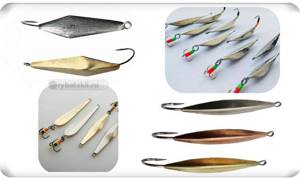
When fishing on first ice, you should not get carried away by the small size of the spoon. Even a small perch actively attacks a spoon 4–6 centimeters in size. From my point of view, lures with small hanging tees, as well as baits with a hanging hook on a chain, which are actively used by our neighbors from Scandinavia, would be superfluous. These spoons are good for mid-winter when the fish are less active. And at the beginning of winter, the perch takes the bait greedily, often swallowing the hanging hook deeply.
It is very difficult to get it out in the cold without damaging it; a special tool is often required. At the same time, your hands get cold, and most importantly, that school of fish that you found and lured to the hole begins to quickly spread out, and after removing the bait, you will have to look for a new, catchy hole.
For the same reasons, do not use very thin fishing lines. A diameter of 0.12-0.14 millimeters will be sufficient. If there is a large perch in the reservoir, the diameter can be safely increased to 0.16-0.18 mm. We do not consider fishing for humpback salmon with a spinner on taiga lakes, where perch can be easily caught with bait the size of a tablespoon and on a fishing line with a diameter of 0.3 mm.
Any winter, light fishing rod is suitable for such fishing. The whip should be soft so that when hooking a fish it does not tear the thin lips of the perch. The fishing rod is equipped with a small short guard, which is recommended for novice anglers. Experienced fishermen rightfully believe that nodding on a perch “spinner” only disrupts the work of the spinner, and the bite of this fish at the beginning of winter can be perfectly felt by hand.
All perch lures, in one way or another, imitate a small runaway top fish, sprat or smelt.
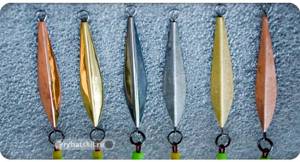
If the perch bite is good, use a spinner with a firmly soldered single hook - it is easier to remove it from the fish in the cold, and when the bite is active.
Sometimes the perch is “capricious”, and this is expressed in rare “pokes” of the fish in the spoon, or “knocks”. It is difficult to hook such a fish. In this case, spinners with a hanging tee - a droplet - are used. The perch's attention is focused not on the body of the spoon, but on the drop itself, and bites become more effective. As I wrote above, you should not use small tees and tees made of thin wire on the first ice.
Balance
It is popular among fishermen to catch active perch on the first ice using a balance beam. When thrown, this bait goes wide to the sides and repeats its movements as a wounded fish, which attracts perch from a large area of water.
As a suspension to the body of the balancer, a tee with a “droplet” or pieces of bright cambric put on it is used.
The fishing rod used is the same as for lure fishing. The balancer is often heavier than a spinner of the same size, so you can use a thicker line, with a diameter of 0.14 millimeters.
The Scandinavian companies Rapala and Nils Master were among the first to have balancers. Now there are many domestic inexpensive baits that are excellent for catching fish. The most popular sizes of Rapala balancers for perch on first ice are 4 and 5 centimeters in length. For catching large perch on the first ice at depths of 5 meters and on rivers with currents, 6-7 centimeter models are also used.
The color range of baits is varied, but two main “colors” of the balancer stand out: acidic (green with black) and combinations of blue back and orange belly.
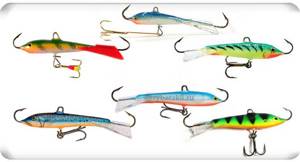
These colors are a must have in the box. Other colors also catch fish from time to time, but you should start fishing with “proven” colors. These baits should be duplicated in the box. The balancer is equipped with side hooks that often catch on underwater obstacles. This is one of the disadvantages of fishing with a balance beam.
Read more about the technique of catching perch with a balance beam and check out the rating of the best models.
When actively fishing on the first ice, and when using a drop-shaped suspension, the number of catches on the front hook is negligible, and it can be carefully bitten off with wire cutters. This will not affect your fishing performance in any way.
Rattlins
Recently, fishing for perch using rattlins has become popular.

It’s difficult for me to talk about the effectiveness of this fishing on the first ice. The bait is equipped with two tees, which complicates active fishing. When catching fish, the second hook tends to dig into the fisherman’s gloves or trouser leg. When fishing for a perch, the second hook often clings to the edge of the hole, and you have to unhook it with a scoop or hand. When fishing on the first ice, the scoop is practically not used and is often kept in a box, and a wet hand quickly freezes in the cold. Not to mention the fact that as a result of these manipulations the fish disappears into the hole.
Therefore, I would leave this bait at home and use it to activate the capricious bite in the middle of winter, as well as for fishing in large bodies of water, where there may be pike perch or pike when fishing.
Mothless
The rewinder is becoming increasingly popular. This is convenient for urban fishermen - a drill, a small fishing rod and a box of jigs. No fuss with baits, baits and their storage. In the first ice conditions, a baitless bait is very useful for perch. Both ordinary uralkas, droplets, pellets, goats, nymphs and bananas with artificial pendants, as well as purely nozzles - balda, devils, nail balls and nail cubes - work.
Skilled non-reelers sometimes catch more than spinners or fans of baited jigs - thanks to the constant search for points. Generalists who go to a pond with the goal of catching fish at any cost, and not just playing with their favorite tackle, can have in their arsenal a spinner, a jig, and a reelless bait, using them depending on the tastes of the fish at that particular time and place.
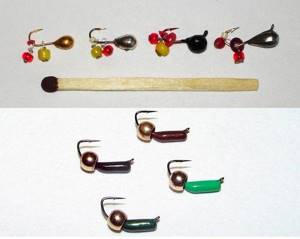
Mothless
The perch takes the first ice with no bait confidently. You just need to find it, choose the right bait and game. The reelless jig is a separate large area of winter fishing with its own nuances, equipment features, baits and fishing techniques used. More details - how to properly catch perch on the first ice using a reelless reel:
https://podlednik.ru/lovlya_zimoj/na-mormyshku/okun-na-bezmotylku-po-pervomu-ldu
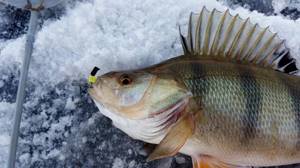
Techniques and tactics of fishing with different tackles
Lures have been purchased, fishing rods have been set up, and you have arrived at a pond that has just become covered with ice that is safe for movement. I’ll tell you about the safety rules at the end of the article, but for now let’s focus on the tactics and techniques of catching perch with a spoon or balance beam on first ice.
The main task on the first ice is to determine the location of the fish.
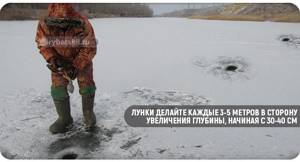
As I wrote earlier, move from shallower to deeper areas. To do this, a series of holes are made, usually from a depth of 30–40 centimeters. Next, holes are made in the direction of the expected increase in depth, every 3–5 meters.
It is also necessary to assess the condition of the snow cover on the ice. On transparent ice, the fish are frightened by sudden movements of the angler, and in very shallow areas, there may be no perch. In this case, the fish are often found on snow-covered spots, where at least a shadow forms on the bottom. At the same time, if the main part of the ice is covered with snow, you should try to catch perch in areas open to snow.
Perch is a curious fish that loves anomalies. And any anomaly - such as: a bend in the coastline, changes in ice cover, changes in depth, a blade of grass or a flooded bush nearby - all these places must be fished on the first ice.
If a fish was caught in one of the holes that were made, or several fish were caught, it is worth paying more careful attention to the coastline at this distance from the shore. To do this, drill several holes not from shallow to deep, but along the coastline. Often a school of perch chooses the same depth for hunting.
Catching perch on the first ice with a spoon
When trolling a perch, you should not stay on one hole for a long time. If there is no perch bite on the first ice within a minute or two, it is better to continue the search. The predator on the first ice is not capricious. If there is one under the drilled hole, he will immediately show interest in the bait.
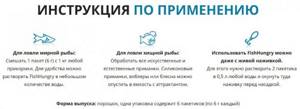
The technique of catching perch in winter from ice with a spoon or a balancer is somewhat similar, and within the framework of this article I will not list various fishing techniques with passion. For the first ice, you need to remember several basic techniques.
You should start fishing by lifting the bait a few centimeters from the bottom, and making a short sharp swing of the fishing rod, tossing the bait. After the swing, you should immediately return the fishing rod to the exact original point. In this case, the bait, be it a spoon or a balancer, returns to the original fishing horizon and swings or rolls from side to side. The bite usually follows in the final stage, during a pause, and is expressed either by hitting the spoon, or, conversely, by hitting the bait from below.
If there is no bite immediately, make several sharp strokes in a row and take a longer pause.
If there is no bite again, you can raise the bait a little, to a height of 30–40 centimeters, and again carry out a series of strokes and pauses of varying amplitude. Often on first ice, fish, and sometimes large perch, stand higher from the bottom.
If there are no bites on the hole, change the hole, gradually exploring interesting places and different fishing depths, and moving along the coastline. Winter fishing for perch on first ice is reminiscent of a game of “sea battle”. You draw out the pond into squares and begin to systematically explore it with bait, pausing and more carefully “drilling” holes in catchable places.
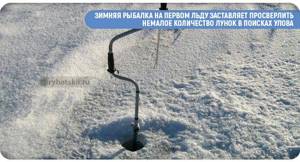
Winter fishing at the beginning of winter is directly proportional to the number of holes drilled per day and meters, and sometimes kilometers, traveled on the ice.
Fishing with a jig
But not all fishing trips with a spoon and a balance beam on the first ice are successful. I found myself in situations where the weather or pressure broke down. What can we say, sometimes such a situation arose in beautiful “perch” weather. Despite the professionalism of our company, the number of perches caught was only a few. The fish, despite its large size, rarely “hit” the spoon and avoided the balancer.
In such situations, it is easier to catch perch on the first ice using a jig. Such a fishing rod must be assembled in a bass fisherman’s box.
Fishing with a jig is exciting in itself, but if the bite is bad with a spinner, it may be the only effective way. Especially if for some reason you can’t move much on the ice. This could be due to its dangerous condition in promising places at the beginning of winter, or bad weather conditions. In such cases, having caught active fish using spinners and balancers, you should try to get the jig tackle out of the box.
A fishing rod for catching perch with a jig is equipped with a thinner line, with a diameter of 0.1 to 0.14 mm and a sensitive guard. The weight of the jig is 0.5-2 grams, from a grain of rice to a small pea. There is a rule: the greater the depth, the heavier the jig is used.
It’s good to have 2-4 fishing rods at once, equipped with different catchy jigs for perch. First of all, of course, jigs should be equipped with bright shiny elements. Secondly, use black options, with bright beads on the hook.
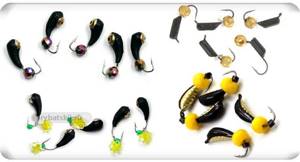
My four favorite basic types of baitless jigs for catching perch are ovsinka, uralka, clove and “ant”. As your skills improve, the angler’s box will be replenished with new models.
Nozzle jig
Catching perch in winter with a jig is sometimes not inferior in catchability to a spinner. On the first ice, it is not necessary to attach a bloodworm or maggot to the hook; it is enough to use a good jig for baitless fishing, purchased in a specialized store, and not in a Chinese shop, and select the game that interests the fish.
Fishing for perch without bait on first ice is very popular in our country, and is worthy of a separate article, but I will focus on some basic techniques.
The drilling procedure and search for catchable holes are no different from lure fishing. Having lowered the jig into the hole, and watching when the jig touches the bottom, you should begin to slowly lift the bait up as you straighten the guard. At the same time, giving it very frequent vibrations with the help of a nod. How high you need to raise the bait depends on many factors.
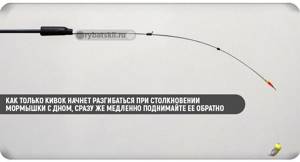
In calm, windless weather, you can bring the jig to the height of the angler’s face, then either swing it and slowly lower it to the bottom, or simply drop the jig to the bottom and start retrieving again.
Avoid sudden and unexpected movements when wiring. A baitless jig should always be in motion; a long pause can give the fish an opportunity to consider the catch. After conducting this series 2-3 times within a couple of minutes, if there is no bite, you should look for the perch in other places.
If you are fishing with a friend, then you can effectively search for fish according to the following scheme. One angler looks for fish with a spoon or balancer, catches it, and, without stopping, leaves the hole when the bite is over. After this, the hole is occupied by an angler fishing with a jig and catching less active perches.
Mormyshka with nozzle
It happens when a fish stops biting even on a baitless jig, but its presence is visible either by light bites, or you use an underwater video camera and see the lack of reaction of the fish to the bait. In such a situation, pause in the active search and try fishing with a jig with bloodworms or maggots.
Extra elements on the jig are not needed. For catching perch with bloodworms, I prefer shiny or combined with black jigs of the “drop” and ball type.
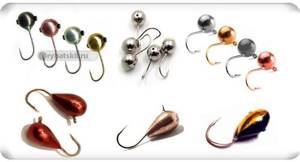
When biting passively, it is better to plant bloodworms in a ring, so the fish have less opportunity to carefully pull off the bait. Make the oscillations of the jig with the bloodworm smoother and the rise slower. You can tap the jig on the bottom, lifting it from the bottom no more than 1–2 centimeters. The attachment on the hook forgives the angler failures and mistakes when playing with a jig, and is suitable for beginners and children. Often, perch bites on a stationary jig with a bloodworm when you decide to take a break from fishing and put your fishing rod on the ice.
Zherlitsy, live bait, sprat and dead fish
On large rivers with a current, where fishing with small spinners, balancers and jigs is not realistic, pike-perch live bait gear - heavy knockers or spinners with the addition of whole or cut dead fish - works successfully. Often large perch take on sprat when fishing for pike perch or bersh at depth with the current. With such gear, fishing is done both while standing and by active play. During the current, you can run the rig further under the ice and fish a larger area.
The striped fish takes fry in any form of equipment - this is its main food supply. Sometimes even quite large live baits are enough on the pike girders, knocking down the fish. In some places and reservoirs, catching perch on the first ice with fry is a fairly common occurrence. The principles of tactics are the same - it is important to look for fish. If it doesn’t take it, rearrange the gear and move on.
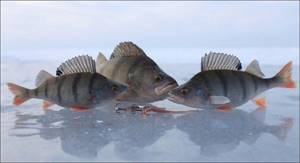
Feeding perch
Feeding perch, especially small ones, is sometimes very effective. If for some reason you cannot drill many holes and move around the water area in search of active fish, you can try to feed the perch to certain holes. In winter, perch responds to bait with bloodworms. If you are fishing in a body of water with stagnant water, such as a lake or pond with shallow depths of up to 2 meters, sometimes it is enough to throw a pinch of bloodworms directly into the hole.
You can use a small feeder and feed the fish near the bottom, opening the feeder 20–30 cm at the bottom. Small portions of bloodworms, the size of a walnut, are sufficient.
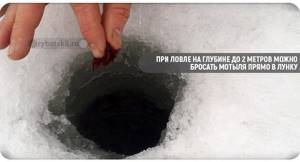
Winter jig fishing
In fact, catching perch with a jig is very diverse. Because jigs are very different. For example, catching perch with a devil is a subtle, interesting game, and it’s different for everyone. Some people prefer smooth, subtle movements of the guard, while others, on the contrary, prefer an aggressive active game of hard steel nods, where vibration reaches maximum values.
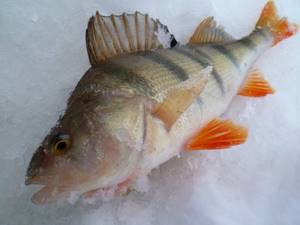
perch on a jig is interesting in its diversity" />
It's very difficult to work as a devil. Especially in smooth movements. Hooking sometimes occurs at the level of intuition. In addition to devils, there are a lot of different baitless jigs.
What else do you need for fishing?
To fish for perch on the first clear ice, you will need an ice pick to check the condition of the ice. The dismountable picks produced by the Tonar plant are convenient. It can even cut small holes in thin ice and move lightly, leaving the ice auger in the car.
If the ice everywhere has reached the required thickness of 10 centimeters or more, it is already difficult to make a hole with an ice pick. To prepare the holes you will need an ice drill. For amateur fishing, you can use ice screws of different diameters; making 5–6 holes with a diameter of 130–150 mm at a time is usually not difficult, and the larger the hole, the less the fishing line touches the edges of the ice, and the later such hole freezes and requires cleaning. The main thing is that the knives are sharp, since ice in cold weather is often strong and solid.
There is another nuance when drilling holes on first ice. While the snow has not yet fallen, and the frost has already frozen the reservoir, a completely typical situation is when the wind blows large areas of sand onto the ice from the shore. If the ice drill knives come into contact with this sand, they will instantly become unusable, and subsequent fishing will be ruined. Go around such areas, and, of course, have a spare set of spare knives in reserve.
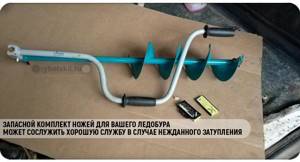
Catching perch in winter with a reelless bait
But this is not given to everyone. It's complicated. First of all, tackle is important. It must be very finely tuned. The thickness of the fishing line and the balance of weight between the guard and the jig also matter.
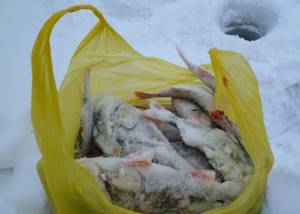
Of course, the first ice is a celebration of the beginning of winter fishing. Friends, comrades, light frost, thin ice, a glass of noble drink, a quick step on clean ice. What else does a person need to be happy?
